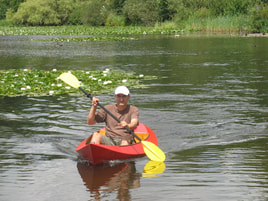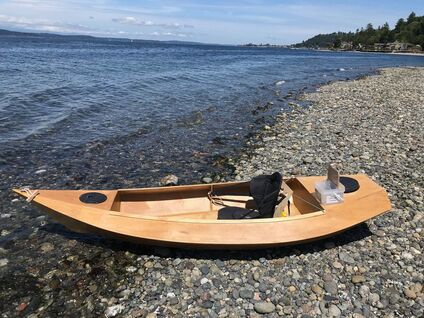
"HAPPY HOUR" PARTICULARS
LOA - 9' (2.80m)
Beam - 39" (0.98m)
Approx.weight - 39lb. (18kg)
Max.payload - 270lb. (120kg)
MORE PHOTOS
This design was inspired by Ross Lillistone's "Water Rat". The bow transom was replaced by a pointed stem. The internal volume and displacement of the boat were increased by about 20%. Changes were made to the seating arrangement as well. Free board was increased to allow more payload. Main purpose of this new design was to provide a stable platform for fly fishermen, nature photographers or bird watchers. The boat has high stability provided by the wide beam, flat bottom and bilge panels (“cheeks”). Anglers can stand up and cast. She handles waves very well without excessive pounding. Most of the waves get absorbed and reflected by the “cheeks”. The boat is also quite maneuverable. Turns can be made right on the spot. As with all short boats tracking can not be compared with a 16’ kayak but is still OK. This is thanks to the large skeg and runner board on the bottom. The runner board creates lateral resistance, protects and stiffens the bottom. There is emergency buoyancy and storage in the front and back. Another nice feature is the light weight of the boat – around 39 lbs (18 kg) if made of exterior grade pine plywood. Easily car topped by one person. There is enough room in the cockpit to take a small child or a dog. The boat can be built for less than $200 CAD (2013). Here is the bill of materials:
· Exterior grade plywood 4x8’ (1220x2440 mm), ¼” (6 mm) thick – 2 sheets;
· Fiberglass tape 3” (75 mm) wide by 6 oz. (200 gr/sq.m) – 33 yards (30 m);
· Epoxy resin – 1 gallon (3.78L) plus hardener;
· Others – bread flour, chip brushes, rollers, fairing compound or filler, paint, sandpaper;
Plans package consists of 3 pages of drawings (metric or imperial) and 5 pages of instructions. Included are plans for a seat and paddle. After payment is processed you will receive an e-mail with two PDF attachments - drawing and work instruction. Plans in imperial units are set up to print on letter size paper at the convenience of your home printer. Metric plans are set up to print on A4 size paper. Technical support is available 24/7 by e-mail.
Hi Alex,
I recently finished building your Happy Hour kayak, and am very pleased with both ease of construction and on-water performance.
The build was done with Home Depot 5mm underlayment plywood (which I first tested for waterproofness) and otherwise per your instructions, though I did install a full-length skeg similar to your Goldfish design. Plans and epoxy were purchased from Duckworks. This was my first boat, and there were no problems with the build, which took about 3 weeks of part time work last month.
I am pleased with the light weight of the Happy Hour; 38.5 lbs with rather heavy seat and hatches, compared to 54lbs for my other kayak. The 9 ft length makes it easy to slide it into the bed of my pickup instead of wrestling it up onto the roof rack, a big help for afternoon impulse paddles.
On the water, the first thing I noticed was the great stability compared to my skinny sea kayak, being able to move around without concern for capsize. I can actually relax and enjoy myself in this boat! The 39 inch width does affect paddling a bit (as expected), but the sloping side decks help, and overall it's a welcome tradeoff for the added stability.
Forward progress and directional stability are both fine (for a 9 ft boat), and the bilge panels do a nice job of deflecting choppy water; great for a relaxing day on the water. All boat designs are compromises, but you have done a fine job balancing these with Happy Hour.
As a previous owner of larger boats that required moorage and related complications, I find myself among the many boaters whittling down to ever smaller and simpler boats. Even my current 16 ft trailer sailer sits unused, as it's too much work to launch and rig for a day sail. It's no exaggeration to say that your little Happy Hour, in both the building and the paddling, has given me more carefree boating pleasure than I've had since my college days 45 years ago.
Best regards,
Jack Loudon
Seattle, WA
LOA - 9' (2.80m)
Beam - 39" (0.98m)
Approx.weight - 39lb. (18kg)
Max.payload - 270lb. (120kg)
MORE PHOTOS
This design was inspired by Ross Lillistone's "Water Rat". The bow transom was replaced by a pointed stem. The internal volume and displacement of the boat were increased by about 20%. Changes were made to the seating arrangement as well. Free board was increased to allow more payload. Main purpose of this new design was to provide a stable platform for fly fishermen, nature photographers or bird watchers. The boat has high stability provided by the wide beam, flat bottom and bilge panels (“cheeks”). Anglers can stand up and cast. She handles waves very well without excessive pounding. Most of the waves get absorbed and reflected by the “cheeks”. The boat is also quite maneuverable. Turns can be made right on the spot. As with all short boats tracking can not be compared with a 16’ kayak but is still OK. This is thanks to the large skeg and runner board on the bottom. The runner board creates lateral resistance, protects and stiffens the bottom. There is emergency buoyancy and storage in the front and back. Another nice feature is the light weight of the boat – around 39 lbs (18 kg) if made of exterior grade pine plywood. Easily car topped by one person. There is enough room in the cockpit to take a small child or a dog. The boat can be built for less than $200 CAD (2013). Here is the bill of materials:
· Exterior grade plywood 4x8’ (1220x2440 mm), ¼” (6 mm) thick – 2 sheets;
· Fiberglass tape 3” (75 mm) wide by 6 oz. (200 gr/sq.m) – 33 yards (30 m);
· Epoxy resin – 1 gallon (3.78L) plus hardener;
· Others – bread flour, chip brushes, rollers, fairing compound or filler, paint, sandpaper;
Plans package consists of 3 pages of drawings (metric or imperial) and 5 pages of instructions. Included are plans for a seat and paddle. After payment is processed you will receive an e-mail with two PDF attachments - drawing and work instruction. Plans in imperial units are set up to print on letter size paper at the convenience of your home printer. Metric plans are set up to print on A4 size paper. Technical support is available 24/7 by e-mail.
Hi Alex,
I recently finished building your Happy Hour kayak, and am very pleased with both ease of construction and on-water performance.
The build was done with Home Depot 5mm underlayment plywood (which I first tested for waterproofness) and otherwise per your instructions, though I did install a full-length skeg similar to your Goldfish design. Plans and epoxy were purchased from Duckworks. This was my first boat, and there were no problems with the build, which took about 3 weeks of part time work last month.
I am pleased with the light weight of the Happy Hour; 38.5 lbs with rather heavy seat and hatches, compared to 54lbs for my other kayak. The 9 ft length makes it easy to slide it into the bed of my pickup instead of wrestling it up onto the roof rack, a big help for afternoon impulse paddles.
On the water, the first thing I noticed was the great stability compared to my skinny sea kayak, being able to move around without concern for capsize. I can actually relax and enjoy myself in this boat! The 39 inch width does affect paddling a bit (as expected), but the sloping side decks help, and overall it's a welcome tradeoff for the added stability.
Forward progress and directional stability are both fine (for a 9 ft boat), and the bilge panels do a nice job of deflecting choppy water; great for a relaxing day on the water. All boat designs are compromises, but you have done a fine job balancing these with Happy Hour.
As a previous owner of larger boats that required moorage and related complications, I find myself among the many boaters whittling down to ever smaller and simpler boats. Even my current 16 ft trailer sailer sits unused, as it's too much work to launch and rig for a day sail. It's no exaggeration to say that your little Happy Hour, in both the building and the paddling, has given me more carefree boating pleasure than I've had since my college days 45 years ago.
Best regards,
Jack Loudon
Seattle, WA
